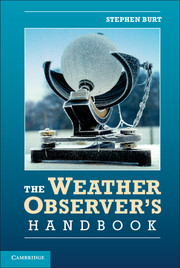Book contents
- Frontmatter
- Contents
- Acknowledgements
- Abbreviations, footnotes and references
- Part One The basics
- Part Two Measuring the weather
- Part Three Making the most of your observations
- 17 Collecting and storing data
- 18 Making sense of the data avalanche
- 19 Sharing your observations
- 20 Summary and getting started
- Appendix 1 Metrology and meteorology: The basics of instrument theory
- Appendix 2 Useful functions
- Appendix 3 Unit conversions
- Appendix 4 Useful sources
- Index
- References
17 - Collecting and storing data
Published online by Cambridge University Press: 05 July 2012
- Frontmatter
- Contents
- Acknowledgements
- Abbreviations, footnotes and references
- Part One The basics
- Part Two Measuring the weather
- Part Three Making the most of your observations
- 17 Collecting and storing data
- 18 Making sense of the data avalanche
- 19 Sharing your observations
- 20 Summary and getting started
- Appendix 1 Metrology and meteorology: The basics of instrument theory
- Appendix 2 Useful functions
- Appendix 3 Unit conversions
- Appendix 4 Useful sources
- Index
- References
Summary
To make the best use of collected weather observations, thought needs to be given to how records are kept: collecting more and more observations is normally a means to an end, rather than an end in itself. Traditional once-daily observations of just a few elements pose few data storage concerns, as they can easily be written up in manuscript in an observations logbook and/or typed up into a small spreadsheet for archiving and analysis purposes. With an AWS in place, however, give careful consideration to managing and storing the avalanche of digital data, which otherwise can quickly become unmanageable and difficult to use. Even a few months of observations can provide useful insights about the climate of a particular location: the longer the record, the better, of course, and implementing an effective record-keeping strategy from the outset will greatly simplify data collection and management as the record length grows. The more effectively records are stored, the easier it is to analyze and use them productively – the subject of the next chapter. This statement applies equally to both professional and amateur observers.
This chapter provides tried and tested suggestions on methods for collecting, storing and archiving data from both manual observations and AWSs. The next chapter outlines techniques for analysing data, building upon the foundations set out in this section. Together they should assist in making best use of collected observations, now and in the future.
Familiarity with the use of spreadsheet software is assumed, as detailed instructions are beyond the scope of this book. Many good ‘teach yourself’ guides are available for the major packages in both hardcopy and online formats.
- Type
- Chapter
- Information
- The Weather Observer's Handbook , pp. 335 - 347Publisher: Cambridge University PressPrint publication year: 2012



